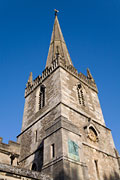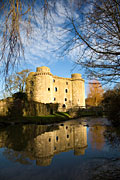Towards the end of the 7th century, St. Aldhelm, Abbot of Malmesbury, set up a mission on the banks of the River Frome. This is believed to have been the first permanent settlement of what became the town of Frome. The site chosen was, at that time, on the edge of Selwood Forest, with several nearby fresh water springs. It was a suitable point at which to cross the river had easy access to many of the tracks crossing the Mendip Hills.
 The church was dedicated to St. John the Baptist and the settlement began to grow. In the Domesday Book a local market is mentioned, indicating that Frome was already a fairly important place. Following the dissolution of the monasteries in 1539, the Church holdings passed to the Thynne family. They later bought more land in this area to develop the Longleat Estate.
The church was dedicated to St. John the Baptist and the settlement began to grow. In the Domesday Book a local market is mentioned, indicating that Frome was already a fairly important place. Following the dissolution of the monasteries in 1539, the Church holdings passed to the Thynne family. They later bought more land in this area to develop the Longleat Estate.
Frome was virtually untouched by the English Civil War, although there was local support for the Parliament. In 1685 the Duke of Monmouth passed through the town whilst trying to recruit an army to overthrow James II. After Monmouth’s defeat at Sedgemoor, the Bloody Assizes, under the infamous “hanging” Judge Jefferies, ended with a number of executions in the town.
 A few miles west of Frome is Nunney Castle. Built for Sir John Delamare in 1373 it is a small French style castle surrounded by a large moat. All that is left of the keep is the south wall and some of the others as during the Civil War, Cromwell's Roundheads blasted a large hole in the northern wall of the castle using a cannon, and leading to the surrender of the garrison. It did however take the best part of three centuries for the wall to completely collapse.
A few miles west of Frome is Nunney Castle. Built for Sir John Delamare in 1373 it is a small French style castle surrounded by a large moat. All that is left of the keep is the south wall and some of the others as during the Civil War, Cromwell's Roundheads blasted a large hole in the northern wall of the castle using a cannon, and leading to the surrender of the garrison. It did however take the best part of three centuries for the wall to completely collapse.
The cloth industry had started in the town during the 14th century. As a result, by the end of the 17th century, Frome was a prosperous town, more so than nearby Bath at this time. Cheap labour and industrialisation in the woollen towns of the north, in the 19th century, speeded the decline of the cloth industry in this area, although the cloth trade did not disappear completely until the 1960s. Frome continued to prosper throughout the Victorian era and later, due to diversification to other industries, particularly printing.
Although the population of Frome has almost doubled over the last fifty years, the town centre has retained its charm. Recently, the town has gained a reputation as a focus for Arts and Crafts and there are a growing number of galleries and craft centres. This has resulted in many craftspeople working from individual workshops producing various specialities from designer jewellery to musical instruments.
The town is still famous for its Wednesday and Saturday markets. There are various conservation areas within Frome, which has retained part of a mediaeval street pattern. The town is built on steep hillsides with winding cobbled streets running down to the river; it still has many interesting domestic and industrial buildings. It is architecturally well preserved and there are more listed buildings in Frome than in any other town in Somerset. There are Town and Heritage Trails to follow and the museum has various exhibitions illustrating the history of the area. Two theatres, an arts centre, a cinema and a concert venue provide a variety of entertainment for both locals and visitors. The local tourist information centre is housed in an old wool drying tower.
Frome has a good range of tearooms, pubs and restaurants and there is plenty of accommodation for the visitor, in and around the town. This is the fourth largest town in Somerset, and a wonderful centre from which to visit the surrounding area.



